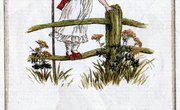Understanding cause and effect is a crucial skill for reading comprehension. Most books have some sort of cause-and-effect relationship, and it is important for students to know how to identify this relationship. This is difficult for some students because they get cause and effect confused. One way to teach this skill is to introduce effects first and have students identify what could have caused them.
Cause-and-Effect Card Game
On index cards, make a list of 20 effects. Write their causes on separate index cards. Only one pair of students can play at a time. Mix up the cards and turn them face down. Each partner should draw seven cards, then make a draw pile with the remainder of the cards. Turn over the top card on the pile and lay it on the table so both players can read it. On his turn, each player may make a match with a card that is turned over or by drawing a card from the pile. His partner must approve the match for it to count. The game ends when one player is out of cards. The winner is the person who has made the most matches.
Read All About It
For this activity, you will read aloud the book "If You Give a Mouse a Cookie" by Laura Numeroff. This book has numerous cause-and-effect relationships. As you read, list the causes and effects on a two-column chart. Your students can illustrate one of the causes and effects from the book to show their understanding.
To extend the concept, have your students write their own story titled "If You Give a Third-Grader Some Pizza." They will enjoy creating their own book and will get great practice with cause-and-effect relationships.
Cause-and-Effect Chain
After reading a story, have students make a cause-and-effect chain. This would be good with stories that had multiple causes and effects, such as "If You Give a Mouse a Cookie." On each link, a student would write a cause and link it with an effect. Then another student could link that effect with another cause. It would be effective for students to see how stories can have multiple causes and effects.
Cause-and-Effect Symbols
Visual aids are helpful to children in learning comprehension skills. Introduce cause and effect with clouds and rain. The cloud would be the cause and the rain would be the effect. As you read a story, ask students where each part of the story fits.
For an extension, have students create a cloud with raindrops. A student would write a cause from the story on the cloud and the effects on the raindrops. Connect the raindrops to the clouds with yarn or string. These can be hung from the ceiling or placed on a bulletin board for a visual reminder.
Related Articles
References
Writer Bio
Courtney Bartlett began writing professionally in 2009. She is currently a freelance writer for "The Mailbox Magazine." She also has been teaching elementary school since 2005. Bartlett holds a Bachelor of Arts in child development and learning from Maryville College. She also holds a Master of Science in elementary education from the University of Tennessee.











